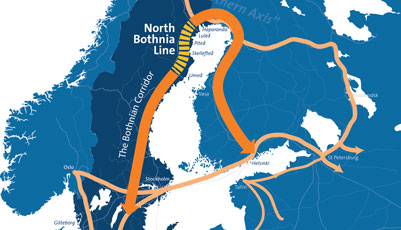The last link in the Bothnian Corridor
Posted: 18 September 2014 | | No comments yet
The North Bothnian Line forms the last link in the Bothnian Corridor which is part of the strategic European mainline rail Core Network. The EU and the Region are willing to finance the line estimated to cost €2.6 billion, and all that is missing now is a positive decision from the Swedish Government, writes Elisabeth Sinclair – Project Leader for the North Bothnian Line Group.


Europe is facing gigantic challenges in meeting the competition from Asia and the USA. One means of doing so is by facilitating commerce and movement in Europe. Consequently the global transport systems have to be aligned. On 19 November 2013, the EU passed the final decision to prioritise the Core Network. Part of this rail network, due for completion by 2030, is the Bothnian Corridor which extends along the Swedish and Finnish sides of the Gulf of Bothnia. Part of the Bothnian Corridor is the North Bothnian Line which is an important section.
The Bothnian Corridor will bring together several rail networks and enable transport to the east-west interchange between the east coast of the USA and the Far East. The 270km-long North Bothnian Line between Umeå and Luleå will connect to the Bothnian Line in the south for onwards transportation towards Europe, the Iron Ore Line in the west leading to Norway and the sea routes, and to the east via the Haparanda Line to the Finnish and Russian rail networks.
Running parallel to the North Bothnian Line, but further inland, is the existing single-track Trunk Line through upper Norrland. Together with the North Bothnian Line it creates a double-track that is missing today, and which opens the opportunity to re-route trains in the event of, for example, rail fracture which is a major concern today.
For more than 10 years the regions along the coast in Northern and Western Bothnia have been protesting the need for a new coastal railway to increase capacity of transportation from the north. The regions are also prepared to back financing of the line which, according to North Bothnian Line plc’s calculations, will cost around €2.6 billion.
The governments of Sweden and Finland have approached the EU Commission stating that the supply of raw materials is of strategic importance to Europe and the associated transport corridors. The dialogue with the EU Commission and the European Parliament has been very good and they have listened to the arguments.
As the line is an important part of the Core Network, the EU is willing to stand for up to 50% of the cost of planning and up to 30% of the construction costs.
When it comes to planning the North Bothnian Line everything is already prepared in the form of railway analysis for the entire route, and once the financing question has been finally negotiated all that remains is to produce railway planning, carry out the procurement processes, dig the first spadeful of earth and lay the tracks.
Lack of capacity on the Trunk Line
More than half of the benefit of the North Bothnian Line comes from more efficient goods transportation for established companies. Northern Sweden has a lot of heavy industry that contributes a large part of the nation’s net export value, both directly and indirectly via refinement in central and southern Sweden. In 2010, the export of forestry and mineral goods accumulated a net worth of 125 billion SEK to the country – a large part of which came from northern Sweden.
The frail century-old singe-track Trunk Line through upper Norrland, which lies some way inland, has too low a capacity. Hills and tight bends mean that the trains cannot be loaded as heavily as in other parts of Sweden.
In a heavily criticised capacity inquiry conducted by the Transport Administration, they claim that major capacity limitations on the Trunk Line through upper Norrland will not occur before 2050. Traffic development has, however, exceeded the Transport Administration’s forecasts. Already in 2012, the line was being utilised by the amount of traffic that the Transport Administration had calculated for 2020. Waiting times for oncoming trains are ineffective and contribute to the Trunk Line through upper Norrland being fully-booked during the times at which goods traffic demands access. There are currently more than 60 trains daily on the Trunk Line through upper Norrland, calculated in both directions, with six billion tonnes of goods to a value of 7 billion SEK annually. There are only seven train slots left to allocate per day on the Boden–Vännäs section, calculated in both directions. This is far too little to be able to meet the foreseen demand. The line itself is approaching a traffic breakdown that will hit commerce and growth in the entire country if a double-track in line with the North Bothnian Line is not built before 2020.
Meeting the lack of capacity through an extension of meeting stations and double-track on the Trunk Line through upper Norrland is not sufficient and would also be significantly more expensive without achieving the societal benefits that would be effected with the North Bothnian Line.
Alternative calculations from the Swedish Transport Administration show that the rail transport volumes from upper Norrland will instead increase by approximately 40% when the North Bothnian Line comes into use. The new track will allow each locomotive to pull 1,600 tonnes instead of 1,000-1,100 tonnes as on today’s Trunk Line. This renders goods traffic effective by 30% and provides the same standard as in the rest of Sweden. The distance is consequently reduced by 70-110km in many important goods contexts. In a recent report presented by Ramböll, a consulting engineering group, the financial losses caused by the absence of the North Bothnian Line are 1.74 billion SEK annually.
92% of EU’s iron ore
The heaviest rail goods flow through the Nordic region is via the Bothnian Corridor. It links together the rich natural resources of northern Europe with the heaviest populated markets in the EU. The North Bothnian Line would action a serious bottleneck in the Bothnian Corridor that obstructs commercial growth. A well-functioning rail infrastructure is a pre-condition for the iron ore-based, metal dependant and forestry-related industry in Sweden. They have heavy transport needs and high demands on delivery safety and continuity. Delivery safety increases significantly with double-tracks.
Raw material extraction and refinement are important to growth. Further refinement with relation to the base industries in the north give a large economical interchange, even in other parts of the country and the rest of Europe. Ninety-two percent of the EU’s iron ore is extracted in the North Bothnian region at an annual value of €2.5 billion. This iron ore is further refined in Sweden to a value of €55 billion. Further refinement continues in Europe to a value of another €550 billion. Additionally, northern Sweden produces a large part of the EU’s gold, lead, zinc, silver and copper. By 2025, the Swedish mining industry is estimated to need a further 50,000 new employees, most of them in northern Sweden.
The forestry industry stands for 12% of Swedish exports, with 40% of forestry production taking place in northern Sweden. Forestry-based commerce creates annual production to a value of 55 billion SEK.
Travel times halved
For passenger traffic, the North Bothnian Line will effectively halve travel times between the coastal towns that lie like a string of pearls with ideal train distances. One strong argument for constructing the North Bothnian Line is that the work commute between Umeå and Luleå is a major problem. This is made very clear in a fresh government report. Business is calling for the right workforce and a coastal railway would widen the labour markets, increase recruitment to higher education and provide higher educated candidates to the labour market. It would also give the population increased access to culture and societal services.
The coast of Norrland is a relatively densely populated part of Sweden. Umeå is home to 110,000 inhabitants, Skellefteå 72,000, Piteå 43,000 and Luleå 73,000, in addition to the smaller areas of populace between the larger towns. This is Sweden’s most heavily populated region without daytime rail traffic. With the advent of the North Bothnian Line, all areas along the coast will be within 45 minutes reach of the universities in Luleå and Umeå. The coast of Norrland is the one area of the country where the greatest effects can be achieved by linking towns together in a better way. The journey time between Luleå and Umeå will be around 90 minutes. And the world doesn’t end at Sweden’s northern border. More than 600,000 people live along the arc around the Gulf of Bothnia. Oulu in Finland lies only 130km from the Swedish border and is a strong and expansive town with a large university and successful IT industry. The North Bothnian Line will enable journey times of around two hours between the universities in Luleå and Oulu.
Tourism in northern Sweden is on the increase and for the companies involved the North Bothnian Line will further offer greater accessibility. The number of guest nights is positively affected by an increase in the scope of communications offered. A new coastal railway will create conditions for developing rail traffic on connecting lines inland and towards the Norwegian and Finnish borders.
The construction of the North Bothnian Line will also provide extensive environmental effects. The trains will run solely on renewable power – consequently, CO2 emissions will be reduced by around 80,000 tonnes annually.
Biography
Elisabeth Sinclair has been the Project Leader of the North Bothnian Line Group since 2009. Prior to working for the association, she participated in the construction of the 190km-long railway between Kramfors and Umeå, The Bothnian Line. Previously, Elisabeth worked with information concerning the environment at the County Administrative Administration of Västerbotten and research concerning medicine at Umeå University and forest sciences at the Swedish University of Agricultural Sciences.







